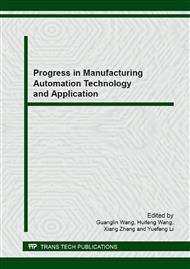p.167
p.171
p.177
p.181
p.186
p.192
p.197
p.202
p.211
Research on Heat Compensation Control of Giant Magnetostrictive Material in the Micro Feed
Abstract:
This paper present a Giant Magnetostrictive Actuators (GMA) which used magnetostrictive characteristics of Giant Magnetostrictive Material (GMM) and is applied on Micro displacement of precision instrument. Since GMM is influenced by temperature and the electrified coils generating magnetic field are the main sources of heat in GMA, so the temperature impacts factors on the output displacement of magnetostrictive material are analyzed firstly, and also a control method based on existing magnetostrictive actuators is redesigned, while model is established according to the relation between output displacement and voltage values. Finally a solution is proposed about heat compensation control in GMA, and also adds a water cooling system to the cavity of GMA and controls the temperature of cooling water by Single Chip Microcomputer (SCM) according to the detected temperature of magnetostrictiverod; therefore compensations for the GMAs feed displacement are allocated. Displacement closed-looped PID controls are used to tests, which can proves that the heat compensation control system of GMA can lower the impact of increasing temperature on GMMs magnetostriction coefficient and increase positioning accuracy.
Info:
Periodical:
Pages:
186-191
Citation:
Online since:
September 2013
Authors:
Price:
Сopyright:
© 2014 Trans Tech Publications Ltd. All Rights Reserved
Share:
Citation:


